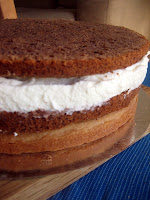Strudel comes from Austria and the most popular version of strudel is with apples, Apfelstrudel. But strudel can be filled with both sweet and savoury, fruits and vegetables, meat and tofu...I have even heard about the strudel filled with sauerkraut, have not seen it yet but as soon as I do, I will document.
The dough and the shape is what makes it a strudel. The dough is slightly thicker then the phyllo dough, and I have seen countless recipes, some have eggs, some don't, some have vinegar, some don't...
I found this particular recipe in a German magazine called Landlust (March/April 09), they had a whole article about the strudel and how you make the perfect dough. I have made it couple of times so far and it has worked perfectly.
One of the most important things is to use a flour that forms strong gluten (bread flour) as all that elasticity and plasticity, that gluten provides, is needed to be able to stretch out the dough very thinly. You also need to use warm water and let the dough rest in the room temperature, the warmer the better.
Strudel doughmakes one strudel
100 gr bread flour (1,5 dl)
pinch of salt
1 tbsp vegetable oil (I used olive)
4 tbsp warm water
Blend flour and salt, add oil and water and kneed the dough for about 5 minutes. The more intensively you kneed the better the gluten will develop and the better the dough will stretch out. Form a ball, the dough should be smooth and soft, something like this:

Sprinkle some flour on a big cloth, put the dough on it and brush it thinly with some oil, cover with a plastic foil and let rest for about 1 hour. After one hour the dough is just a little bit flatter, much more softer and looks like this:

Sprinkle some flour on the top of the dough and press with your finger tips until you have flatten it:

Roll out the dough as thinly as you can, just be careful not to make any foldings. I got a rectangle 35x45 cm:

Now carefully lift one side of the dough, and starting in the middle stretch the dough with your hands:

Stretch the dough from all sides until you have a very thin sheet, or something close to 60x70 cm. Cut the edges all around, about 5 cm, and you will have a dough that is ready to become a strudel.

 Obatzda is Bavarian cheese-spread that can be found on the menu in every beer-garden. Every beer-garden has its own spice mixture that is added to the cheese. Some of the spices often used are sweet paprika, caraway, onions and beer. There are probably as many variations as there are beer-gardens.
Obatzda is Bavarian cheese-spread that can be found on the menu in every beer-garden. Every beer-garden has its own spice mixture that is added to the cheese. Some of the spices often used are sweet paprika, caraway, onions and beer. There are probably as many variations as there are beer-gardens.

















































